|
English quilter, textile researcher & historian
Celia Eddy has just written her sixth quilt book, Quilted Planet, A Sourcebook of Quilting Traditions and Techniques
Around the World,
which focuses on quilts made today & yesterday, far & wide around
our world.
The Personal Side |
Genesis and Scope of the Book |
Page two: Quilts in "Quilted Planet" |
British Quilt Study Group | Contact Info
The Personal Side
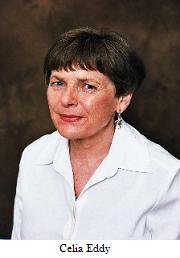 Celia’s
newest quilt book is international in scope, as is her personal
story. She began quilting about 30 years ago. Oriental Patchwork,
by Maggie Lane, was one of the first books she read about
quiltmaking. She “fell in love with the style of Japanese patchwork
dating back to the 16th century.” The method, look and symbolism she
discovered about it inspired her immensely. She said “I’ve made
every member of my family at least one such patchwork garment, and
some for special friends, as gestures of love and respect. Being
able to include information about Japanese patchwork and quilting in
QP was a great joy.” It looks similar to the crazy style without
fancy embellishments. (for a picture see pages 26-29 in QP) Celia’s
newest quilt book is international in scope, as is her personal
story. She began quilting about 30 years ago. Oriental Patchwork,
by Maggie Lane, was one of the first books she read about
quiltmaking. She “fell in love with the style of Japanese patchwork
dating back to the 16th century.” The method, look and symbolism she
discovered about it inspired her immensely. She said “I’ve made
every member of my family at least one such patchwork garment, and
some for special friends, as gestures of love and respect. Being
able to include information about Japanese patchwork and quilting in
QP was a great joy.” It looks similar to the crazy style without
fancy embellishments. (for a picture see pages 26-29 in QP)
|
Well known for her
books on different quilt making methods, use of color
and block designs, Celia recognized the universality of
quilted textiles and patchworks through time and across
geographic locations. QP is fully loaded, with 250
photographs, large sized full shots and large sized
detail shots. Sometimes I ran my hand across the photos
I was so fooled for a moment. The colors are rich. Save
about a dozen, the quilts were fresh to my eyes and her
captions both interesting and informative. They contain
tidbits of history, whether it be cultural, historical,
textile or about provenance. In fact, most of the book’s
pages are dedicated to photographs. Describing textile
cultural traditions of a region introduces chapters and
each quilt. Full size quilts, cushions, wall hangings,
clothing and other quilted items specific to a region’s
traditions are shown. Each chapter has traditional and
contemporary art quilts, with some of them made by
quilters known here; for example, Pat Campbell from
Texas, Ted Storm-van Weelden from Netherlands, and Judy
Severson from California. |
 |
 |
There is another side
of Celia’s current life which I was surprised to
discover. It is a unique part of her and Tim’s life at
home. Tim Longville has been her partner for the last 33
years. Atop low sandy cliffs, called “Sea Brows”, which
run along the edge of the Solway Firth, sits their
mid-Victorian town house situated on the edge of a
“cobbled square of eighteenth and early nineteenth
century houses.” The Solway Firth is the stretch of
water dividing north-west England from south-west
Scotland. There are wonderful views across the Firth to
the hills of Dumfriesshire and Galloway. On a clear day,
Celia said they can see the hills on the Isle of Man to
the south. |
Together Celia and Tim restored it to the period featuring
all the glorious details it offered them. They decorated it
in furnishings from the time, turning The Brown House into
their home for the last twenty years. She displays quilts
she made all around their three-story home, on top of
tables and as throws, folded, and on the walls. Although
Celia doesn’t call herself a collector, she is a quilt maker
and does have a few antique quilts in her private
collection. She acquires quilts with a known provenance,
either local or significant to her. They are avid collectors
of books about their favorite subjects and each built up a
substantial library room in their home. Tim, also an author,
is a gardening journalist, a poet and a publisher, a
“general man-about-letters,” as they say in England.
|
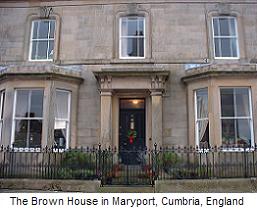
![]() |
| With
Celia’s art flanking the walls inside, Tim engaged his artistry to
build a “secret garden” in-between the Victorian red sandstone walls
of their back yard.
Given their warmer coastal climate, he was able to fill his garden
with “rare and semi-tender plants.” About 10 years ago the National
Gardens Scheme asked him to open his garden to the public for tours,
which he agreed to on behalf of this charity. Little did either of
them know then how this would change their life.
|
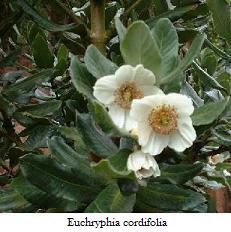 |
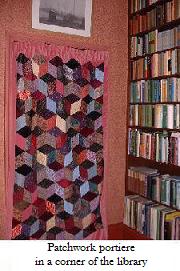 “It all began the first time we ever opened the garden to the public
for charity. Visitors had to come into the hallway to pay, thence
into the garden. Our daughter was on duty selling tickets, while we
were fully occupied with the hordes in the garden. Suddenly Vaseema
came racing into the garden: 'Come quick. They're all over the
house!' It hadn't “It all began the first time we ever opened the garden to the public
for charity. Visitors had to come into the hallway to pay, thence
into the garden. Our daughter was on duty selling tickets, while we
were fully occupied with the hordes in the garden. Suddenly Vaseema
came racing into the garden: 'Come quick. They're all over the
house!' It hadn't
 occurred
to us to rope off the rest of the house, so seeing quilts hanging up
the stairwell, many people had decided to follow the quilt trail
rather than going straight into the garden. Sure enough, they'd got
as far as the attics and were enjoying a good look at everything.
There was nothing for me to do but talk them through what was there,
but it gave me the idea of opening specifically to show the quilts
and my Workroom. Since then, it's been a regular occurrence.” Their
visitors are encouraged to rifle through the library books and hunt
for quilts all over the house of the "quilter in residence." The
Brown House is open by appointment, should you be
vsiting England. occurred
to us to rope off the rest of the house, so seeing quilts hanging up
the stairwell, many people had decided to follow the quilt trail
rather than going straight into the garden. Sure enough, they'd got
as far as the attics and were enjoying a good look at everything.
There was nothing for me to do but talk them through what was there,
but it gave me the idea of opening specifically to show the quilts
and my Workroom. Since then, it's been a regular occurrence.” Their
visitors are encouraged to rifle through the library books and hunt
for quilts all over the house of the "quilter in residence." The
Brown House is open by appointment, should you be
vsiting England.
Celia has a great interest in all things Indian, which began in her
youth. She was born in London shortly before WWII. When her father
was sent to India in the Royal Signals Corp, her family moved to
Cornwall for the duration. She followed in her father’s legal
footsteps, married young and gave birth to her daughter Vaseema,
whose paternal side was from India. Celia was welcomed into their
family and she developed a love of India’s arts, history and culture
as this is an important part of her daughter and granddaughter’s
heritage.
She has dedicated a part of QP to textiles from different regions in
India. Her book includes the easily recognized Indian palampores and
Indian chintz, and lesser known, but distinctive quilted and
embroidered Indian styles, Kanthas and Sujunis. Large photos, which
show details and quilting or embroidery stitching, accompany this
cultural background of all the quilts in this book, Realizing now, I
have seen these in antique shops and at swap meets and I passed them
by. I couldn’t place them or know if they were the real thing of
cultural origins. (pages 40-51)
Celia studied Islamic arts
and crafts through her contacts with the American quiltmaker,
the late Margit Echols. Celia’s enthusiasm to learn complex
piecing techniques led her to replicate Moorish tile
patterns in many of her patchworks. Of ralli quilts, she
says that their patterns and colors “embody all the romance
and exoticism of the East.” Did you know that in the Indus
region of Pakistan, where many rallies are made for dowries
to this day, the word ‘ralli’ means to ‘mix’ or ‘connect’.
One of the ralli quilts pictured in QP looks like a bar
quilt of flying geese, surrounded by a thin Sawtooth border
and a wider border of a square-in-a-square on point. The
similarity with American quilts is undeniable, but their
pattern came from pottery made there in c. 2000 BC. The
colors of the quilt and pottery are earth colors, buff,
rusts and browns. (page 43)
What made this woman, who went through law school, then
turned to teaching elementary and special needs students,
who then became head of Department of large Comprehensive
Schools, retire fifteen years ago (at 54) and turn her
quilting hobby into her profession? |
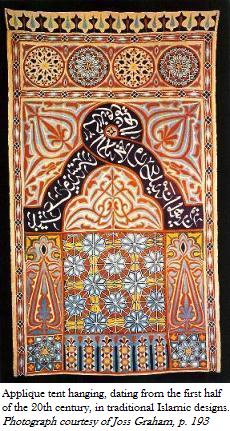 |
My impression following this
interview is that Celia is driven by curiosity and seeks new
adventures with an openness and intelligence that sets her on
different courses as she moves through life. She loves to learn and
then share this new knowledge with others. Her personality is warm
and dynamic. She is a vibrant woman that defies her current age in
every way. Her life, past and present, appears as colorful as her
books and fabrics, and undoubtedly, the inside of the Brown House
too.
Genesis and Scope of
the Book
Jonathan Holstein’s
books, The Pieced Quilt and Abstract Design in American Quilts
influenced her, she tells me, to look more deeply into the
“American side of the story.” She became keenly interested in
understanding why America’s quilting traditions developed as they
did, and then she wanted to know the same about the UK’s quilt
history. “I was surprised to discover that there was no single book
where I could get an overview of quilts world-wide, although it
seemed clear that quilts and quilting techniques were present in
many, many cultures. Von Gwinner’s book, The History of the
Patchwork Quilt, was the only book I could find which attempted
any sort of broad picture, but it was far from comprehensive.”
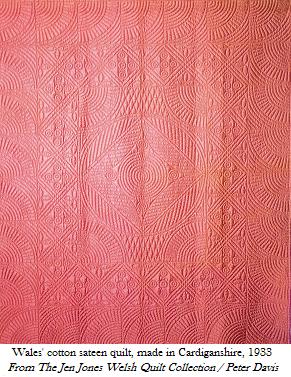 When
asked how she chose which countries to include in her book, she said
“ I decided to make the book as broad in scope as possible, giving
due prominence to the regions which have been influential and are
well-known, UK and America, for example - but encompassing as many
other, perhaps less familiar, areas as possible. I aimed to
celebrate the ubiquity of the quilt as a cultural phenomenon and to
indicate its importance and relevance to many different people in
diverse geographical and social contexts.” When
asked how she chose which countries to include in her book, she said
“ I decided to make the book as broad in scope as possible, giving
due prominence to the regions which have been influential and are
well-known, UK and America, for example - but encompassing as many
other, perhaps less familiar, areas as possible. I aimed to
celebrate the ubiquity of the quilt as a cultural phenomenon and to
indicate its importance and relevance to many different people in
diverse geographical and social contexts.”
It took a year of focused research and writing to get the book to
the publishers. “I’d been collecting information and books about
quilts of all nations for years – UK, Indian, Japanese, American,
Australian quilts and others in which I had reasonable working
knowledge. There were quite a few cultures and traditions about
which I knew only vaguely – Hawaiian and Korean quilts, for example.
Again, networking and working through the Internet pointed me to the
people and books I needed. It was great to have the excuse to buy
large numbers of books which I might otherwise have lusted after but
resisted!”
She often expressed how helpful the internet was in making contacts,
getting permissions, finding sources and viewing quilts, “I also met
and talked to many interesting and knowledgeable people whom I might
otherwise never have know.” I couldn’t help but think about the
resulting globalization of the world for quilters since the internet
and eBay came into our lives. The scope and timing of Quilted Planet
seems to fit in like a “y’ seam, for the ‘dedicated quilter’, as we
are now called by marketing firms. The continuity of quilt
traditions worldwide which Celia investigates is clearly
demonstrated in this book, proving there really is nothing entirely
new under the sun, just different shades of color.
To illustrate my point, I turn to a contemporary quilt, 2004, which
could easily come out of the juried art quilt exhibits Visions
or Quilt National. It is technically called a pojagi (Korean
wrapping cloth) in Korea. Chunghie Lee used sheer fabrics in shades
of reds to form a patchwork that reflected in the light shows moiré,
wood grain, crosshatch and other designs shining through. Both
diagonal and straight black threaded seams divide the many pieces
unequally giving the illusion of stained glass window you can almost
see through. In one ‘window’ only there is a flowering vine and
leafy branch. Words can not adequately describe this artistic quilt.
The other contemporary Korean quilt uses hand fabrics in shades of
blue, cut into jigsaw puzzle pieces, two per unit, which are blended
to form depth like looking into the opening of a cave on the side of
a mountain or wall. Misik Kim named her 2002 quilt “the Wall’
symbolizing the walls we have around us in life, both visible and
invisible, for good or bad. “Walls are not just barriers - they can
represent security and warmth too.” What woman or man can’t relate
to this? (pages 38-39)
The publishers left the quilt choices and photos entirely up to
Celia’s discretion, while the layout and style were their decision.
Of course the publisher’s eyes were on salability, but Celia was
happy with their choice of a large format and full-page
illustrations, even if it pared down the text. On balance, she
thinks it was the right decision, as so many readers have commented
on the value of the large photos.
Using quilts she had seen in books, at exhibits or galleries, in
museums and in personal collections, she and her “full-time picture
researcher assistant, Emma, tracked down and negotiated for the loan
of all the illustrations.” On rare occasion, a quilt she requested
“was not obtainable, in which case she and Emma would track down a
suitable alternative.”
Continue to
page two . . . |